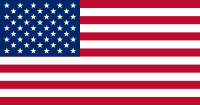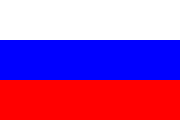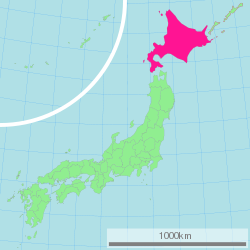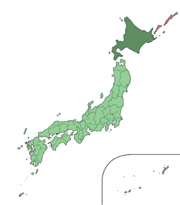Hokkaidō
|
||||||||||||||||||||||||||||||||||||||||||||||||||||
|
||||||||||||||||||||||||||||||||||||||||||||||||||||
Hokkaidō (北海道? literally "North Sea Circuit"), formerly known as Ezo, Yezo, Yeso, or Yesso, is Japan's second largest island and the largest, northernmost of its 47 prefectural-level subdivisions. The Tsugaru Strait separates Hokkaidō from Honshū, although the two islands are connected by the underwater Seikan Tunnel. The largest city on Hokkaidō is its capital, Sapporo, which is also its only ordinance-designated city.
Contents |
History

Archeologists theorize that Hokkaidō was settled by Ainu, Gilyak, and Oroke 20,000 years ago.[1] The Nihon Shoki is often said to be the first mention of Hokkaidō in recorded history. According to the text, Abe no Hirafu[2] led a large navy and army to northern areas from 658 to 660 and came into contact with the Mishihase and Emishi. One of the places Hirafu went to was called Watarishima (渡島), which is often believed to be present-day Hokkaidō. However, many theories exist in relation to the details of this event, including the location of Watarishima and the common belief that the Emishi in Watarishima were the ancestors of the present-day Ainu people.
During the Nara and Heian periods, people in Hokkaidō conducted trade with Dewa Province, an outpost of the Japanese central government. From the medieval ages, the people in Hokkaidō began to be called Ezo. Around the same time Hokkaidō came to be called Ezochi (蝦夷地) or Ezogashima. The Ezo mainly relied upon hunting and fishing and obtained rice and iron through trade with the Japanese.
During the Muromachi period, the Japanese created a settlement at the south of the Oshima peninsula. As more people moved to the settlement to avoid battles, disputes arose between the Japanese and the Ainu. The disputes eventually developed into a rebellion. Takeda Nobuhiro killed the Ainu leader, Koshamain[3], and defeated the rebellion. Nobuhiro's descendants became the rulers of the Matsumae-han, which ruled the south of Ezochi until the end of the Edo period.
Matsumae-han's economy relied upon trade with the Ainu. The Matsumae family was granted exclusive trading rights with the Ainu in the Azuchi-Momoyama and Edo periods. During the Meiji Restoration, the Tokugawa Shogunate realized there was a need to prepare northern defenses against a possible Russian invasion and took over control of most of Ezochi. The Shogunate made the plight of the Ainu slightly easier, but did not change the overall form of rule.
Hokkaidō was known as Ezochi until the Meiji Restoration. Shortly after the Boshin War in 1868, a group of Tokugawa loyalists led by Enomoto Takeaki proclaimed the island's independence as the Republic of Ezo, but the rebellion was crushed in May 1869. Ezochi was subsequently put under control of Hakodate-fu (箱館府, Hakodate Prefectural Government). When establishing the Development Commission (開拓使), the Meiji Government changed the name of Ezochi to Hokkaidō (北海道).
The primary purpose of the development commission was to secure Hokkaidō before the Russians extended their control of the Far East beyond Vladivostok. Kuroda Kiyotaka was put in charge of the venture. His first step was to journey to the United States and recruit Horace Capron, President Grant's Commissioner of Agriculture. From 1871 to 1873 Capron bent his efforts to expounding Western agriculture and mining with mixed results. Capron, frustrated with obstacles to his efforts returned home in 1875. In 1876 William S. Clark arrived to found an agricultural college in Sapporo. Although he only remained a year, Clark left lasting impression on Hokkaidō, inspiring the Japanese with his teachings on agriculture as well as Christianity.[4] His parting words, "Boys, be ambitious!" can be found on public buildings in Hokkaidō to this day. Whatever the impact these Americans had, the population of Hokkaidō boomed from 58,000 to 240,000 during that decade.[5]

In 1882, the Development Commission was abolished, and Hokkaidō was separated into three prefectures, Hakodate (函館県), Sapporo (札幌県), and Nemuro (根室県). In 1886, the three prefectures were abolished, and Hokkaidō was put under the Hokkaidō Agency (北海道庁). Hokkaidō became equal with other prefectures in 1947, when the revised Local Autonomy Law became effective. The Japanese central government established the Hokkaidō Development Agency (北海道開発庁) as an agency of the Prime Minister's Office in 1949 to maintain its executive power in Hokkaidō. The Agency was absorbed by the Ministry of Land, Infrastructure and Transport in 2001. The Hokkaidō Bureau (北海道局) and the Hokkaidō Regional Development Bureau (北海道開発局) of the Ministry still have a strong influence on public construction projects in Hokkaidō.
Naming of Hokkaidō
When establishing the Development Commission (開拓使), the Meiji Government decided to change the name of Ezochi. Matsuura Takeshirō submitted six ideas, including names such as Kaihokudo (海北道) and Hokkaidō (北加伊道) to the government. The government eventually decided to use the name Hokkaidō, but decided to write it as 北海道, as a compromise between 海北道 and because of the similarity with names such as Tōkaidō (東海道). According to Matsuura, the name was thought up because the Ainu called the region Kai. Historically, many peoples who had interactions with the ancestors of the Ainu called them and their islands Kuyi, Kuye, Qoy, or some similar name, which may have some connection to the early modern form Kai. The Kai element also strongly resembles the Sino-Japanese reading of the characters 蝦夷 (Sino-Japanese /ka.i/, Japanese kun /emisi/), which have been used for over a thousand years in China and Japan as the standard orthographic form to be used when referring to Ainu and related peoples; it is possible that Matsuura's Kai was actually an alteration, influenced by the Sino-Japanese reading of 蝦夷 Ka-i, of the Nivkh exonym for the Ainu, namely Qoy.
Geography


The island of Hokkaidō is located at the north end of Japan, near Russia, and has coastlines on the Sea of Japan, the Sea of Okhotsk, and the Pacific Ocean. The center of the island has a number of mountains and volcanic plateaus, and there are coastal plains in all directions. Major cities include Sapporo and Asahikawa in the central region and the port of Hakodate facing Honshū.
The governmental jurisdiction of Hokkaidō incorporates several smaller islands, including Rishiri, Okushiri Island, and Rebun. (By Japanese reckoning, Hokkaidō also incorporates several of the Kuril Islands.) Because the prefectural status of Hokkaidō is denoted by the dō in its name, it is rarely referred to as "Hokkaidō Prefecture", except when necessary to distinguish the governmental entity from the island.
The island ranks 21st in the world by area. It is 3.6% smaller than the island of Ireland while Hispaniola is 6.1% smaller than Hokkaidō. By population it ranks 20th, between Ireland and Sicily. Hokkaidō's population is 4.7% less than that of the island of Ireland, and Sicily's is 12% lower than Hokkaidō's.
Seismic activity
Like the rest of Japan, Hokkaidō is seismically active. Aside from numerous earthquakes, the following volcanoes are still considered active (at least one eruption since 1850):
- Mount Koma
- Mount Usu and Showashinzan
- Mount Tarumae
- Mount Tokachi
- Mount Meakan
- See also: Category:Volcanoes of Hokkaidō
In 1993, an earthquake of magnitude 7.8 generated a tsunami which devastated Okushiri, killing 202. An earthquake of magnitude 8.0 struck near the island on 25 September 2003 at 19:50:07 (UTC).
National Parks and quasi-national parks
There are still many undisturbed forests in Hokkaidō, including:
| National parks | |
|---|---|
| Shiretoko National Park* | 知床 |
| Akan National Park | 阿寒 |
| Kushiro Shitsugen National Park | 釧路湿原 |
| Daisetsuzan National Park | 大雪山 |
| Shikotsu-Toya National Park | 支笏洞爺 |
| Rishiri-Rebun-Sarobetsu National Park | 利尻礼文サロベツ |
* designated a World Heritage Site by UNESCO on 2005-07-14.
| Quasi-national parks (準国立公園) | |
|---|---|
| Ōnuma Quasi-National Park | 大沼 |
| Niseko-Shakotan-Otaru Kaigan Quasi-National Park | ニセコ積丹小樽海岸 |
| Abashiri Quasi-National Park | 網走 |
| Hidaka Sanmyaku-Erimo Quasi-National Park | 日高山脈襟裳 |
| Shokambetsu-Teuri-Yagishiri Quasi-National Park | 暑寒別天売焼尻 |
- Twelve prefectural natural parks (道立自然公園).
| Ramsar sites | ||
|---|---|---|
| since | ||
| Kushiro Wetland | ja:釧路湿原 | 1980-06-17 |
| ja:クッチャロ湖 | 1989-07-06 | |
| ja:ウトナイ湖 | 1991-12-12 | |
| Kiritappu Wetland | ja:霧多布湿原 | 1993-06-10 |
| ja:厚岸湖・別寒辺牛湿原 | 1993-06-10, enlarged 2005-11-08 |
|
| ja:宮島沼 | 2002-11-18 | |
| ja:雨竜沼湿原 | 2005-11-08 | |
| Sarobetsu Mire | ja:サロベツ原野 | |
| ja:濤沸湖 | ||
| ja:阿寒湖 | ||
| ja:野付半島・ja:野付湾 | ||
| ja:風蓮湖・ja:春国岱 | ||
Subprefectures

Hokkaidō is one of eight prefectures in Japan that have subprefectures or local offices (the others being Tokyo, Yamagata Prefecture, Nagasaki Prefecture, Okinawa Prefecture, Kagoshima Prefecture, Miyazaki Prefecture and Shimane Prefecture). However, it is the only one of the eight to have such offices covering the whole of its territory outside the main cities (rather than having them just for outlying islands or remote areas). This is mostly due to its great size: many parts of the prefecture are simply too far away to be effectively administered by Sapporo. Subprefectural offices in Hokkaidō carry out many of the duties that prefectural offices fulfill elsewhere in Japan.
|
|
|
Before the current political divisions and after 1869, Hokkaidō was divided into provinces. See Former Provinces of Hokkaidō.
Climate

Hokkaidō is known for its cooler summers and icy winters. Most of the island falls in the humid continental climate zone (Köppen Dfa (humid continental) in some inland lowlands, Dfb (hemiboreal) in most other areas). The average August temperature ranges from 17 °C to 22 °C (63 °F to 72 °F), while the average January temperature ranges from −12 °C to −4 °C (10 °F to 25 °F) depending on elevation and latitude. The island tends to see isolated snowstorms that develop long-lasting snowbanks, in contrast to the constant flurries seen in the Hokuriku region.
Unlike the other major islands of Japan, Hokkaidō is normally not affected by the June-July rainy season and the relative lack of humidity and typically warm, rather than hot, summer weather makes its climate an attraction for tourists from other parts of Japan.
In winter, the generally high quality of powder snow and numerous mountains in Hokkaidō make it one of Japan's most popular regions for snow sports. The snowfall usually commences in earnest in November and ski resorts (such as those at Niseko, Furano and Rusutsu) usually operate between December and April. Hokkaidō celebrates its winter weather at the Sapporo Snow Festival.
During the winter, passage through the Sea of Okhotsk is often complicated by large ice floes broken loose from the Kamchatka Peninsula. Combined with high winds that occur during winter, this brings air travel and maritime activity almost to a halt on the northern coast of Hokkaidō.
Major cities and towns
- See also: List of cities in Hokkaidō
Hokkaidō's largest city is the capital, Sapporo. Other major cities include Hakodate in the south and Asahikawa in the central region. Other important population centers include Kushiro, Obihiro, Abashiri, Nemuro.
Hokkaidō has the highest rate of depopulation in Japan. In 2000, 152 (71.7%) of Hokkaidō's 212 municipalities were shrinking. Total shrinking municipalities in Japan in the same year number 1,171.
Economy
Although there is some light industry (most notably paper milling, beer brewing) most of the population is employed by the service sector. In 2001, the service sector and other tertiary industries generated more than three quarters of the gross domestic product.[6]
However, agriculture and other primary industries play a large role in Hokkaidō's economy. Hokkaidō has nearly one fourth of Japan's total arable land. It ranks first in the nation in the production of a host of agricultural products, including wheat, soybeans, potatoes, sugar beet, onions, pumpkins, corn, raw milk, and beef. Hokkaidō also accounts for 22% of Japan's forests with a sizable timber industry. The prefecture is also first in the nation in production of marine products and aquaculture.[6]
Tourism is an important industry, especially during the cool summertime when visitors are attracted to Hokkaidō's open spaces from hotter and more humid parts of Japan. During the winter, skiing and other winter sports bring other tourists, and increasingly international ones, to the island.[7]
Transportation
Hokkaidō's only land link to the rest of Japan is the Seikan Tunnel. Most travelers to the island arrive by air: the main airport is New Chitose Airport at Chitose, just south of Sapporo. Tokyo-Chitose is in the top 10 of the world's busiest air routes, handling 45 widebody round trips on four airlines each day. One of the airlines, Air Do was named after Hokkaidō. Hokkaidō can also be reached by ferry from Sendai, Niigata and some other cities, with the ferries from Tokyo dealing only in cargo .
Within Hokkaidō, there is a fairly well-developed railway network (see Hokkaidō Railway Company), but many cities can only be accessed by road.
Hokkaidō is home to one of Japan's three Melody Roads, which is made from grooves cut into the ground, which when driven over causes a tactile vibration and audible rumbling transmitted through the wheels into the car body.[8][9]
Education
The Hokkaidō Prefectural Board of Education oversees public schools in Hokkaidō. The board directly operates public high schools. [1] has a list of public high schools in Japanese.
Sports
The 1972 Winter Olympics were held in Sapporo.
The sports teams listed below are based in Hokkaidō.
Football
- Consadole Sapporo (Sapporo)
Baseball
- Hokkaidō Nippon Ham Fighters (Sapporo)
Ice Hockey
- Nippon Paper Cranes (Kushiro)
- Oji Ice Hockey Team (Tomakomai)
Basketball
- Rera Kamuy Hokkaido (Sapporo) Japan Basketball League (JBL)
Friendship partners
Hokkaidō has relationships with several provinces, states, and other entities worldwide.[10]
 Alberta, Canada, since 1980
Alberta, Canada, since 1980 Heilongjiang, China, since 1980
Heilongjiang, China, since 1980 Massachusetts, United States of America, since 1988
Massachusetts, United States of America, since 1988 Sakhalin Oblast, Russia, since 1998
Sakhalin Oblast, Russia, since 1998 Busan, South Korea, since 2005
Busan, South Korea, since 2005 Gyeongsangnam-do, South Korea, since 2006
Gyeongsangnam-do, South Korea, since 2006
As of July 2008, 73 individual municipalities in Hokkaidō have sister city agreements with 111 cities in 19 different countries worldwide.[11]
See also
- Kuril islands dispute
- 2006 Kuril Islands earthquake
- 2006 Kuril Islands tsunami
- Asia League Ice Hockey
- Former Hokkaidō government office building
- Sankebetsu brown bear incident
References
- Walter A. McDougall, Let the Sea Make a Noise: A History of the North Pacific from Magellan to MacArthur, Basic Books, New York, 1993
- J. D. Bisignani, Japan Handbook, Moon Publications Inc., Chico, 1993
- ↑ Japan Handbook', p. 760
- ↑ ibid.
- ↑ ibid.
- ↑ Let the Sea Make a Noise: A History of the North Pacific from Magellan to MacArthur,pp. 355–356
- ↑ Let the Sea Make a Noise: A History of the North Pacific from Magellan to MacArthur,p. 357
- ↑ 6.0 6.1 "Hokkaido's Business Environment". Trade and Economic Exchange Group, Commerce and Economic Exchange Division, Department of Economic Affairs, Hokkaido Government. Retrieved on 2008-12-05.
- ↑ Takahara, Kanako (July 8, 2008). "Boom time for Hokkaido ski resort area" (in English), The Japan Times, The Japan Times Ltd.. Retrieved on 2008-09-27.
- ↑ Johnson, Bobbie (13 November 2007). "Japan's melody roads play music as you drive", The Guardian (Farringdon Road, London, England), GMG, p. 19 (International section). Retrieved on 20 October 2008.
- ↑ "Your car as a musical instrument - Melody Roads". Noise Addicts (29 September 2008). Retrieved on 20 October 2008.
- ↑ "Exchange Affiliates". Retrieved on 5 December 2008. (English)
- ↑ 市町村の姉妹友好提携 (Sister city partnerships). Retrieved on 5 December 2008. (Japanese)
External links
- Hokkaido Official Website
- TransGlobal Highway – Proposed Hokkaidō-Sakhalin Friendship Tunnel.
- Sea-Girt Yezo: Glimpses at Missionary Work in North Japan, by John Batchelor 1902 account of life and Anglican missionary work on Hokkaidō
- Unbeaten Tracks in Japan, Isabella L. Bird, 1878 travelogue of Victorian-era woman traveller, Hokkaido letters
- Hokkaipedia
- Brazilian Hokkaido Association
- Hokkaidō travel guide from Wikitravel
|
|||
| Subprefectures | |||
|---|---|---|---|
| Abashiri | Hidaka | Hiyama | Iburi | Ishikari | Kamikawa | Kushiro | Nemuro | Oshima | Rumoi | Shiribeshi | Sorachi | Sōya | Tokachi | |||
| Cities | |||
| Abashiri | Akabira | Asahikawa | Ashibetsu | Bibai | Chitose | Date | Ebetsu | Eniwa | Fukagawa | Furano | Hakodate | Hokuto | Ishikari | Iwamizawa | Kitahiroshima | Kitami | Kushiro | Mikasa | Monbetsu | Muroran | Nayoro | Nemuro | Noboribetsu | Obihiro | Otaru | Rumoi | Sapporo (capital) | Shibetsu | Sunagawa | Takikawa | Tomakomai | Utashinai | Wakkanai | Yūbari | |||
| edit |
|
|||||||||||
|
|||||

